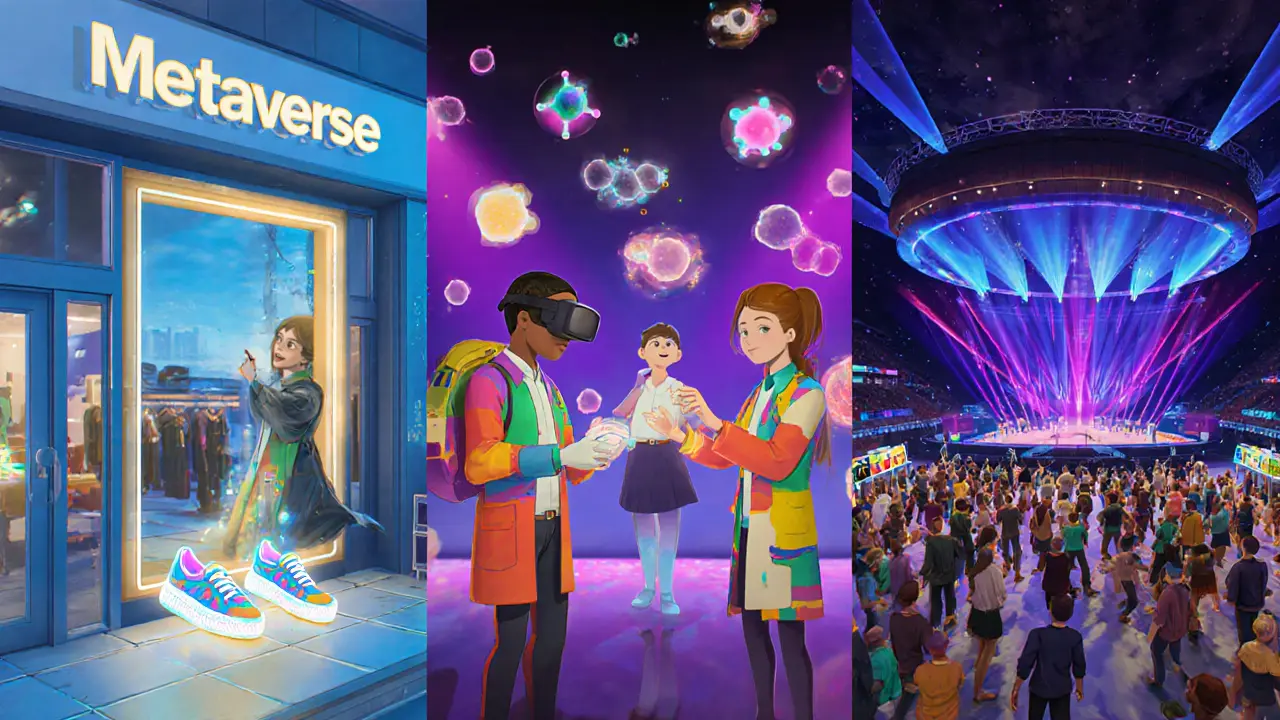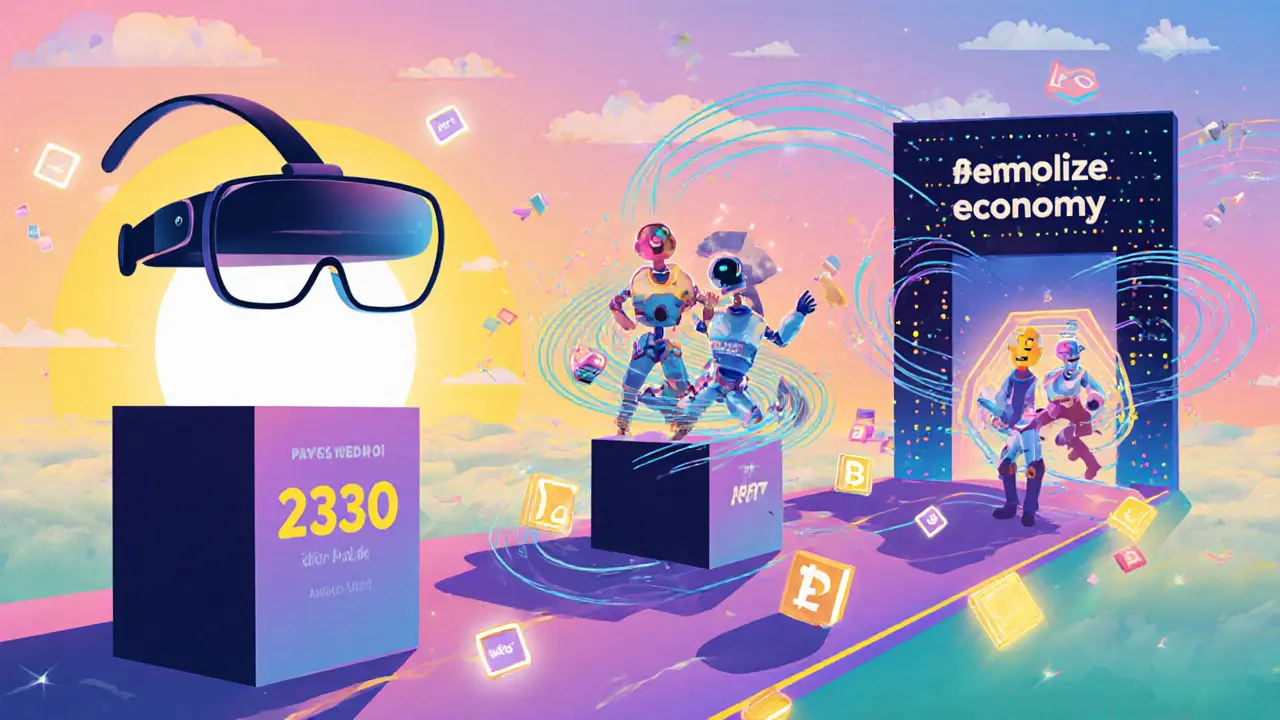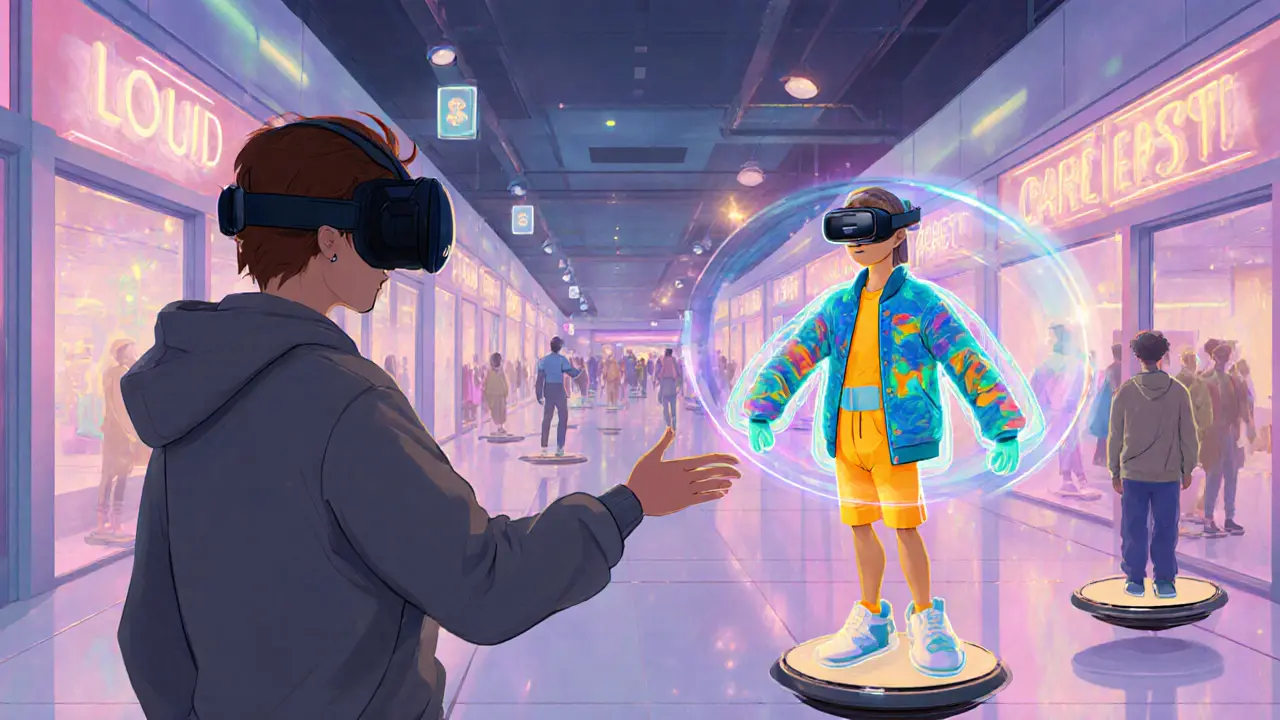Metaverse Technology Impact Calculator
User Engagement Boost
0%
Revenue Potential
$0M
ROI Projection
0%
Impact Summary
Enter values and click calculate to see projected business impact of Metaverse adoption.
Imagine walking into a digital mall, chatting with a lifelike avatar, and buying a jacket that appears instantly on your closet - all without leaving your living room. That vision is what the Metaverse a persistent, shared 3D environment that blends virtual and physical worlds promises. As of 2025, the metaverse technology landscape is shifting from hype to practical, industry‑driven applications, and the next few years will decide if it becomes a new digital frontier or a niche playground.
Defining the Metaverse and Its Core Pillars
At its heart, the Metaverse is a network of interoperable virtual spaces that users can access via smartphones, computers, or head‑mounted displays. Seven technical pillars keep it running:
- Blockchain decentralized ledgers that secure transactions and enable true ownership of digital assets
- AR/VR augmented and virtual reality hardware that delivers immersive visual experiences
- Artificial Intelligence machine‑learning models that personalize avatars, content, and virtual assistants
- 5G high‑speed, low‑latency networks that let users interact in real time
- Edge Computing processing power placed close to devices to reduce lag for massive IoT data streams
- Internet of Things sensors and smart devices that bridge physical objects with their digital twins
- 3D Reconstruction photogrammetry and modeling tools that turn real‑world environments into lifelike virtual spaces
Each pillar adds a layer of realism, security, or speed, and together they form the foundation for tomorrow’s digital ecosystems.
Where the Metaverse Stands in 2025
Major tech giants - Meta, Microsoft, and Epic Games - have rolled out platforms that let brands build virtual stores, host concerts, or run remote training. Small‑to‑mid‑size startups specialize in niche experiences such as virtual fashion shows or collaborative design studios. Investment reports show a steady $15‑$20billion annual inflow into Metaverse‑related projects, with retail, education, and entertainment leading adoption.
Key statistics from 2025:
- Over 120million active monthly users across all public Metaverse platforms.
- Average session length increased to 45minutes, up 30% from 2023.
- Enterprise pilots report a 22% boost in employee engagement when training is delivered in VR.
- Digital asset sales (NFTs, virtual land) generated $2.8billion in Q2 alone.
These numbers indicate that the technology is no longer a novelty; it’s becoming a measurable business channel.
Industry‑Specific Use Cases That Are Already Paying Off
Retail: Brands like Nike and Gucci have opened virtual flagship stores where shoppers can try on 3D shoes via AR mirrors, pay with crypto, and receive a physical shipment the next day. Early adopters see a 15% lift in average order value because the immersive try‑on reduces return rates.
Education: Universities deploy VR labs for chemistry experiments, allowing students to manipulate molecules in real time without safety concerns. Studies from the University of Texas show a 12% improvement in test scores compared to traditional labs.
Entertainment: Live concerts in virtual venues attract global audiences. A recent festival in Decentraland sold 500000 tickets, each priced at $10, and generated $5million in merch sales within the platform.
Corporate Collaboration: Companies use persistent virtual offices for cross‑border teams. Microsoft Mesh reports that 40% of Fortune500 firms plan to transition 30% of their meetings to mixed‑reality spaces by 2027.

Challenges That Still Hold Back Mass Adoption
Despite growth, several pain points keep the Metaverse from mainstream domination:
- Hardware Cost - High‑end VR headsets still cost $600‑$1200, while sleek AR glasses remain in prototype phases. This price barrier limits consumer reach.
- Scalability - Hosting millions of concurrent avatars demands edge‑distributed servers. Many platforms experience lag spikes during big events.
- Regulatory Uncertainty - Data‑privacy rules for virtual interactions are still evolving, especially around biometric data captured by AR devices.
- User Experience - Current interfaces can feel clunky; navigation often relies on controller buttons rather than natural gestures.
- Interoperability - Moving assets across different Metaverse ecosystems still requires manual conversion, hampering the vision of a seamless digital universe.
Addressing these issues will be the main focus for developers and policymakers over the next three years.
Future Roadmap: What to Expect by 2030
Analysts converge on three trajectories that will shape the next wave of Metaverse development:
- Hardware Evolution: Lightweight AR glasses priced under $300 are slated for 2027, making everyday overlay of digital information as normal as checking a smartwatch.
- AI‑Driven Personalization: Generative AI will craft custom avatars and environments on the fly, reducing content‑creation time from weeks to minutes.
- Decentralized Economies: Blockchain will enable true cross‑platform asset ownership, allowing users to sell a virtual car bought in one world to a buyer in another without friction.
Beyond 2030, the Metaverse may become a utility layer - much like the internet today - where everyday apps (banking, health monitoring, civic services) run inside persistent virtual spaces.
How Businesses Can Get Ahead Today
For companies eyeing a foothold, a phased approach works best:
- Define Clear Value: Identify a problem the Metaverse solves better than a 2D website (e.g., virtual product demos that cut sales cycle).
- Partner with Experts: Hire a development studio experienced in Unity/Unreal, blockchain integration, and UX for immersive environments.
- Start Small: Launch a pilot - a single virtual showroom or a VR training module - and measure KPIs such as engagement time and conversion rate.
- Build for Interoperability: Use open standards (GLTF for 3D models, ERC‑721 for NFTs) so assets can migrate later.
- Plan Governance: Establish data‑privacy policies that comply with GDPR‑like regulations for biometric and location data.
Following this roadmap helps avoid costly re‑builds when the underlying tech matures.
Metaverse vs. Traditional Digital Platforms - A Quick Comparison
| Aspect | Metaverse | Traditional Platforms |
|---|---|---|
| Presence | 3D immersive, avatar‑driven interaction | 2D screens, mouse/keyboard navigation |
| Economy | Tokenized assets, crypto payments, NFT ownership | Fiat payments, centralized account balances |
| Interoperability | Potential cross‑world asset transfer (still emerging) | Isolated ecosystems, limited data sharing |
| Hardware Requirement | VR/AR headset or AR‑enabled mobile device | Any internet‑connected device |
| User Engagement | Average session 45min, higher emotional recall | Average session 8‑12min, lower retention |

Frequently Asked Questions
What hardware do I need to access the Metaverse?
You can start with a modern smartphone that supports ARKit or ARCore for basic experiences. For full immersion, a VR headset (e.g., Meta Quest 3) or upcoming AR glasses (projected under $300 by 2027) will provide the best experience.
Is the Metaverse secure for financial transactions?
Security hinges on blockchain protocols. Public chains like Ethereum use proof‑of‑stake consensus, offering strong cryptographic guarantees. However, users must still protect private keys and follow best practices against phishing.
Can traditional businesses benefit without building a full‑scale world?
Absolutely. A single virtual showroom, a branded VR training module, or an NFT‑based loyalty program can deliver tangible ROI while keeping development costs manageable.
How will regulations affect Metaverse adoption?
Governments are drafting rules around biometric data, virtual land ownership, and crypto taxation. Clearer guidelines will reduce legal risk and encourage more enterprises to invest, especially in regulated sectors like finance and healthcare.
What’s the biggest “killer app” on the horizon?
Experts point to collaborative design studios that let engineers, designers, and clients co‑create 3D products in real time. The blend of AI assistance, instant rendering, and blockchain‑secured IP could replace many legacy CAD workflows.
How long does it take to develop a Metaverse experience?
Simple virtual presence can be built in weeks using existing platforms. A fully custom, brand‑specific world with integrated blockchain and AI typically requires 6‑12months and a multidisciplinary team.
Whether you’re a startup testing a virtual pop‑up or a global brand planning a persistent digital campus, the Metaverse is moving from speculation to concrete value. By understanding the core technologies, acknowledging current limits, and planning for the next wave of hardware and AI, you can position your organization to ride the biggest digital transformation of the decade.


Everyone's gushing about the metaverse like it's the next salvation, but they ignore the fact that most of these platforms are just glorified sandboxes for the wealthy. The hardware costs are obscene and the ROI numbers are inflated by PR teams. If you ask me, it's a fad powered by venture capital hype rather than real consumer demand.
Wow the article really breaks down the tech you can see why it feels like we are stepping into a new era it’s exciting to think about how education could become so immersive it could change the way we learn forever
Reading through the pillars feels like peering into a modern alchemy where blockchain is the philosopher’s stone, AI the omniscient sage, and 5G the swift messenger. Each component interlocks, yet we must remember that the whole is only as strong as its weakest link. The narrative is vibrant, but the practical scaffolding is still under construction.
Another clueless hype piece that pretends the metaverse is a solved problem. The so‑called "scalability" is a joke when you see the lag during events. If you think crypto will magically solve ownership, you’re living in a delusion.
Super cool breakdown! 😃 I love how you highlighted the retail use‑cases – imagine trying on shoes virtually without leaving my couch. This is exactly the kind of fun tech we need more of! 🎉
Okay, let’s talk drama – the metaverse is basically the glitzy stage where big brands play dress‑up while the rest of us watch. Everyone’s shouting “future”, but the real story is about who gets to own the spotlight and the NFTs.
When you consider the evolution of digital interaction, the metaverse represents a paradigm shift akin to the transition from mainframe computing to personal computers, and this shift is not merely cosmetic but fundamentally alters how value is created and exchanged in virtual ecosystems; the convergence of AR, VR, AI, and blockchain creates a layered infrastructure that supports both persistent identity and emergent economies, allowing avatars to own, trade, and monetize digital assets across previously siloed platforms, which in turn stimulates a new class of creators who can leverage generative AI to produce content at unprecedented speeds, reducing production cycles from weeks to mere hours; furthermore, the integration of edge computing reduces latency to sub‑30‑millisecond thresholds, a critical factor for delivering seamless immersive experiences, especially in collaborative environments where real‑time interaction is paramount, and this technical foundation underpins the rise of virtual workplaces that promise to cut travel costs and increase employee engagement, as evidenced by the 22% boost reported by enterprise pilots; however, the journey is riddled with challenges, such as the high cost of head‑mounted displays, the need for robust privacy frameworks to protect biometric data, and the ongoing struggle for interoperable standards that would allow assets to move freely between worlds, a hurdle that developers must overcome to realize the vision of a truly open metaverse; despite these obstacles, the market’s willingness to invest billions signals confidence that the ecosystem will mature, and early adopters who experiment with single‑purpose virtual showrooms or training modules stand to gain competitive advantages by gathering granular usage analytics that inform product iteration, ultimately leading to higher conversion rates and reduced return frequencies; in summary, the metaverse is poised to become a utility layer akin to the internet, where everyday applications embed themselves within persistent, three‑dimensional spaces, reshaping commerce, education, and social interaction for the next decade and beyond.
One must consider the hidden cabal influencing the narrative; the elites fabricate the metaverse hype to funnel capital into shadowy blockchain consortia, ensuring that true decentralization remains a myth while they retain control over the underlying ledgers. This orchestrated spectacle serves their agenda, and the average consumer is merely a pawn.
Let’s keep our eyes on the possibilities – even if the tech isn’t perfect yet, the ability to bring people together in immersive spaces can spark creativity and foster community. Small steps, like a virtual meetup for hobbyists, can pave the way for larger breakthroughs. Stay motivated, stay curious.
From a systems integration perspective, the metaverse stack requires a symbiotic relationship between heterogeneous protocols – leveraging OAuth for identity federation, utilizing CRDTs for state synchronization, and employing zero‑knowledge proofs to safeguard privacy without compromising auditability. Overlooking these technical nuances leads to brittle implementations.
In cross‑cultural deployments, it is essential to adapt avatar representation and interaction paradigms to respect local norms, thereby enhancing user adoption rates. The article’s global outlook is commendable, yet practical localization strategies remain under‑discussed.
Wow, that was a marathon read! I totally agree with the point about latency – it’s the silent killer of immersion. Thanks for breaking it down in detail.